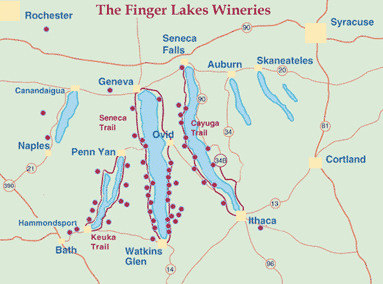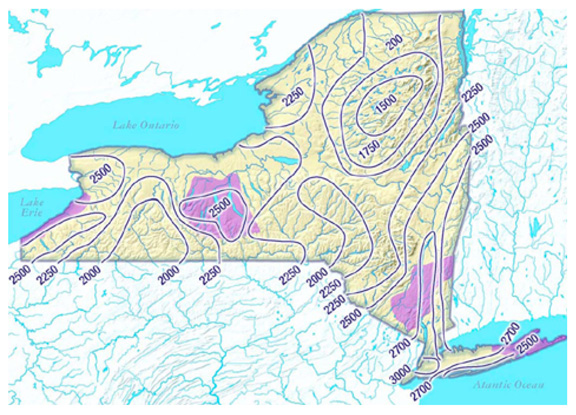Geology & Viticulture: An Earthcache
Cayuga Lake Wine Trail is the oldest in the country. The Finger
Lakes Region is home to over 100 wineries, hosts 9,000 acres of
vineyards and crushes approximately 41,300 tons of grapes
annually.
Rocks and Wine?
Geology is more than the just identifying rocks. Some of the
oldest and most interesting applications of geology involve
interactions between people and the noble grape, Vitis vinifera.
Mounds of grape seeds have been found in prehistoric caves. Early
on, humans recognized the relationship between the geology of an
area and the success of various crops. Records of the ancient
Egyptians and Greeks contain observations that certain regions
seemed to produce better wine than others.

Viticulture in New York
Second only to California in wine production, New York has been
producing wines since the earliest days of the US. The Finger Lakes
are the main wine producing area in New York State. The Finger
Lakes American Viticulture Area encompasses roughly 2.3 million
acres and is named for the 11 Finger Lakes (from west to east:
Conesus, Hemlock, Canadice, Honeoye, Canandaigua, Keuka, Seneca,
Cayuga, Owasco, Skaneateles, and Otisco Lakes). Wine making in the
Finger Lakes dates back to 1829 when William Botswick planted vines
in his rectory garden in Hammonsport. This region contains the
first winery in the United States.

It’s COLD here! Why are the Finger Lakes good for growing
grapes?
Many factors affect the success of grape growing. Physical
characteristics of a location, the geology, topography, soil and
climate all influence grapes and the resulting wine. This concept
is known as ‘terroir’, which means that all factors work together
to create a region with particular wine characteristics. For the
Finger Lakes, two important physical characteristics are
immediately obvious, the sloping topography and the deep lakes.
Both of these elements were created by glacial activity thousands
of years ago when the advance and retreat of the glaciers carved
out the Finger Lakes and landforms found here today.
The aspect and slope of where a vine is planted has an effect on
the grapes. A 30 degree slope facing south can double the amount of
sun the grapes receive. In a flat planting, the vines on either
side of any given row will block sunlight to the rows next to it.
But when the vines are on a hill, the sun can hit all the grapes
hanging down on every row. A sloped hill also offers better
drainage, and more air circulation. During the last ice age, these
sloping hillsides along Cayuga Lake were carved and formed.
But what really makes viticulture possible at all here is the
glacial lakes themselves. New York has a much colder climate than
California, or France or Spain. Spain is considered a hot wine
production region similar to the central valley of California. Even
though New York is at about the same latitude as northern Spain,
New York is much cooler and exhibits a continental rather than
maritime climate. A continental climate is characterized by greater
temperature extremes between summers and winters. Without the
lakes, temperatures for growing wine grapes here would be too low.
It is not the width or surface area of the lakes, but rather their
depth, that has an influence on viticulture. The deep lakes, carved
through glacial activity, serve as heat sinks. This moderates cold
temperatures in the winter and delays bud-break in the spring until
risks of frost have passed. The radiating effect of the lakes also
extend the length of the growing season, but this is a very
localized effect, so vineyards and wineries are clustered along the
north/south orientations of the major lakes (Cayuga, Seneca and
Keuka). Cayuga Lake is the longest and second deepest of the Finger
Lakes at 38 miles long and 435 feet deep.

What are Growing Degree Days?
The Growing Degree Day (or Winkler Scale) works on the
assumption that plants will grow at or above a specific minimum
temperature. For grapes, it has been determined that growth begins
at the mean temperature of 50 degrees Fahrenheit. Using simple
math, one can figure out if an area will have enough warm days
between April 1 and August 31 (growing season) to successfully grow
grapes. Days in the growing season are assigned ‘Degree Days’
according to the amount that the day’s average temperature exceeds
the minimum threshold for growth: one Degree Day is assigned per
degree Fahrenheit over 50 degrees. All the day’s scores are then
added up, for a total Accumulated Degree Days. This calculation
allows you to evaluate one of the elements necessary to support
viticulture. The chart below outlines some common wine making
regions, their latitude, and their accumulated seasonal Degree
Days.

Four areas in New York have enough growing Degree Days to
support winemaking. These are the Erie Lakeshore, the Finger Lakes,
the Hudson Valley and the tip of Long Island. The illustration
below charts accumulated growing degree days for the state, with
grape growing regions shown in pink.
 To Log this Earthcache you need to complete the following
tasks:
To Log this Earthcache you need to complete the following
tasks:
- Take a photo of yourself with your GPS at the arched trellis on
site with the lake in the background.
- Calculate the growing degrees your day contributed to the
grapes here. Look up the temperature high and low on the day of
your visit. Determine the mean temperature for the day. Subtract
50. (In the winter, it is likely that your day will subtract from
the total growing degree days, and be a negative number).
- In your log, post your photo and your math.
- Send me an email with the answer to the following question:
Name two geological properties of this site that support the
growing of grapes and explain how they do so.
Sources:
Finger Lakes Geology
(http://www.priweb.org/ed/finger_lakes/nystate_geo1.html)
Geology of New York, Y.W. Isachen, E. Landing, J.M. Lauber, L.V.
Rickard, W.B. Rogers, editors
Roadside Geology of New York, Bradford B. Van Diver
Overview of New York Geology
(http://gretchen.geo.rpi.edu/roecker/nys/nys_edu.pamphlet.html)
Terroir of the Finger Lakes of New York by Larry Meinert &
Tara Curtin Vineyard Site Evaluation
(http://arcserver2.iagt.org/vll/learnmore.aspx)
Wines NY.com (www.winesny.com/NewYorkWines)
WineEducation.com (www.wineeducation.com/regny.html)
Cayuga Wine Trail (www.cayugawinetrail.com)
Analysis of Lakeside Deposits: Seneca Lake, Geneva, New York by
Bridget Martin
Richard Leahy’s Wine Report
(http://www.richardleahy.com/blog/2008/10/06/an-introduction-to-the-wines-of-the-finger-lakes-ny),
Wineries at “I Love the Finger Lakes”
(http://www.ilovethefingerlakes.com/entertainment/wineries.htm)